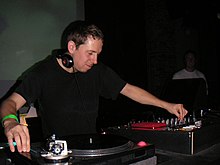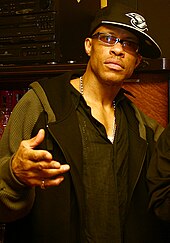| This article may contain excessive or irrelevant examples. Please help improve the article by adding descriptive text and removing less pertinent examples. (September 2018) |
| Acid jazz | |
|---|---|
 The logo of Acid Jazz Records, where the name was coined The logo of Acid Jazz Records, where the name was coined | |
| Stylistic origins | |
| Cultural origins | 1980s, United Kingdom |
| Derivative forms | |
Acid jazz (also known as club jazz, psychedelic jazz, or groove jazz) is a music genre that combines elements of funk, soul, and hip hop, as well as jazz and disco. Acid jazz originated in clubs in London during the 1980s with the rare groove movement and spread to the United States, Western Europe, Latin America and Japan. Acts included The Brand New Heavies, Incognito, James Taylor Quartet, Us3, and Jamiroquai from the UK, and Guru, Buckshot LeFonque and Digable Planets from the U.S. The rise of electronic club music in the middle to late 1990s led to a decline in interest, and in the twenty-first century, acid jazz became indistinct as a genre. Many acts that might have been defined as acid jazz are seen as jazz-funk, or nu jazz.
Characteristics

Etymology
The genre's name was likely coined by Gilles Peterson, and the label was started by Bangs, Eddie Piller, and Gilles. The name refers to the acid house genre, which was popular in UK clubs in the 1980s. However, DJs Femi Williams and Marco Nelson from Young Disciples claimed in a recently unearthed 1992 TV interview that they coined the term because they had a club with acid playing downstairs and jazz upstairs, so they thought it would be amusing to name the upstairs room "The Acid Jazz Room". The veracity of this claim predating Peterson's is dubious, as the interview in question took place five years after the Acid Jazz label was created, and Young Disciples were first active three years after the formation of the label.
Evolution
Acid jazz consisted of two related movements. The first was based on records by disc jockeys and music producers who added percussion and electronic dance beats to jazz tracks from the 1960s and 1970s. The second movement included groups who were influenced by these recordings and who emphasized a groove. Acid jazz borrowed from jazz, funk, and hip-hop. Because it relies heavily on percussion and live performance, it is sometimes associated with jazz, but its emphasis on groove aligns it more with funk, hip hop, and dance music. The style is characterized by danceable grooves and long, repetitive compositions. Acid jazz bands usually include horns, a rhythm section (bass guitar, drum set and additional percussion), a vocalist who may sing or rap, and a DJ.
History

Origin
Acid jazz has its origins in the 1950s, 1960s, when psychedelic styles were being incorporated into other musical genres, jazz being one of these. Acid jazz became popular in London clubs during the 1980s when disc jockeys associated with the rare groove movement played obscure jazz records. Their interests were in the fringe of jazz fusion, jazz funk, and the soul jazz of 1960s. Particularly significant were records from the Blue Note catalogue. These DJs included Gilles Peterson, who had residencies at several London clubs in the 1980s. Peterson began in a small pirate radio station and then moved to the larger Kiss-FM. In 1988 with producer Eddie Piller he formed the label Acid Jazz Records. The first release from the company was the compilation Totally Wired, which contained obscure jazz funk tracks from the 1970s with updated new tracks.
In 1990 Peterson left to start the label Talkin' Loud at Phonogram. The company signed Galliano, Young Disciples, and Urban Species. Another British record label, Fourth and Broadway Records, was formed in 1990 and began a compilation series with the title "The Rebirth of Cool". The label's roster included Pharoah Sanders, Stereo MCs, MC Solaar, and Courtney Pine.
In 1991 acid jazz broke into the mainstream with the success of Brand New Heavies. After one self-titled album (1990) with Acid Jazz Records, the group signed with FFRR Records and had the hit singles "Never Stop" and "Dream Come True". Other bands included Incognito and Us3, whose "Cantaloop (Flip Fantasia)" (1993) was the biggest hit in the genre. Also successful was Jamiroquai, an early act for Acid Jazz Records that signed with Sony, which released Travelling Without Moving (1996) and the hit single "Virtual Insanity". Other live acts included Stereo MCs and the James Taylor Quartet. The mainstream success of acid jazz was followed by many compilations which left the public confused about the genre.
Acid jazz in the US

Acid jazz spread to the United States in the early 1990s. It reached New York City in 1990 when British promoter Maurice Bernstein and his South African partner Jonathan Rudnick opened Groove Academy as a party at the Giant Step club in the basement of the Metropolis Café in Union Square. Groove Academy turned into a record label and media company. Acid jazz musicians in New York City included Brooklyn Funk Essentials, DJ Smash, and Jerome Van Rossum. In San Francisco acid jazz was released by Ubiquity Records, by Solsonics in Los Angeles, and The Greyboy Allstars in San Diego.
A Tribe Called Quest borrowed from jazz for their album The Low End Theory (1991). Under the name Buckshot LeFonque, Branford Marsalis and Digable Planets won a Grammy Award for the 1993 single "Rebirth of Slick (Cool Like Dat)".
Formed in New York in 1990, Groove Collective produced their self-titled debut in 1993. The rapper Guru released a series of albums recorded with jazz musicians as the Jazzmatazz series.
Stemming from Chicago in 1993, Liquid Soul achieved a national profile in 1996 when their self-titled debut LP was re-released by Ark21. In 2000 their album Here's the Deal was nominated in the Grammy Award for Best Contemporary Jazz Album category.
Around the world
Acid jazz soon gained an international following, including in Japan, Germany, Brazil and Eastern Europe. From Japan, United Future Organization gained an international reputation, signing an American record deal in 1994. Other acts from Japan included Mondo Grosso, and Gota Yashiki Skalpel came from Poland.
Decline
The rise of electronic club music in the mid- to late-1990s led to a decline in interest in acid jazz among the record buying public, although the genre continued to have a reduced worldwide following. In the twenty-first century the movement became so intertwined with other forms that it became indistinct as a genre and many acts that might have been defined as acid jazz are now seen as jazz funk, neo soul or jazz rap.
Q magazine stated "Acid jazz was the most significant jazz form to emerge out of the British music scene". One major legacy of the genre is its influence on the jam band movement, with acid jazz proving a suitable medium for extended improvisation for acts such as Medeski, Martin and Wood and The Greyboy Allstars.
See also
References
- Cook, Richard (2005). Richard Cook's Jazz Encyclopedia. London: Penguin. p. 2. ISBN 0-141-00646-3.
- "Acid jazz (genre)". Grove Music Online. 2001. doi:10.1093/gmo/9781561592630.article.53045. ISBN 978-1-56159-263-0. Retrieved 28 February 2021.
- Adams, Simon (2002). Kernfeld, Barry (ed.). The New Grove Dictionary of Jazz (2 ed.). New York City: Grove's Dictionaries. p. 10. ISBN 978-1-56159-284-5.
- ^ Bush, John (2001). Bogdanov, Vladimir (ed.). All Music Guide to Electronica. San Francisco, California: Backbeat Books. pp. 647–649. ISBN 0-87930-628-9.
- ^ Price, E.G.; Kernodle, T.L., eds. (2011). Encyclopedia of African American Music. Santa Barbara, California: ABC-CLIO. pp. 479–482. ISBN 978-0-313-34199-1.
- "Jamiroquai". ABC listen. 5 October 2023. Retrieved 9 October 2023.
- "Jamiroquai". ABC listen. 5 October 2023. Retrieved 9 October 2023.
- ^ Gioia, Ted (2011). The History of Jazz (2 ed.). Oxford: Oxford University Press. pp. 333–334. ISBN 978-0-19-983187-6.
- ^ "Acid Jazz Music Genre Overview". AllMusic. Retrieved 13 September 2020.
- Berry, Mick; Gianni, Jason (2004). The Drummer's Bible. Tucson, Arizona: See Sharp Press. p. 68. ISBN 1-884365-32-9.
- Larkin, Colin (1998). The Virgin Encyclopedia of Dance Music. New York City: Virgin Books. p. 334. ISBN 978-0-7535-0252-5. Retrieved 2 July 2013.
- ^ Martin, Henry; Waters, Keith (2011). Jazz: The First 100 Years (3 ed.). Cengage Learning. p. 362. ISBN 978-1-133-16927-7.
- Cooke, Mervyn; Horn, David, eds. (2002). The Cambridge Companion to Jazz. Cambridge: Cambridge University Press. p. 237. ISBN 0-521-66388-1.
- "Greyboy Allstars | Biography & History". AllMusic. Retrieved 24 August 2021.
- Ankeny, Jason. "Liquid Soul". AllMusic. Retrieved 13 September 2020.
- "Liquid Soul". GRAMMY.com. 23 November 2020. Retrieved 24 August 2021.
- J. Ankeny, "United Future Organization", in V. Bogdanov, ed., All Music Guide to Electronica: The Definitive Guide to Electronic Music (Milwaukee: Backbeat Books, 2001), ISBN 0-87930-628-9, p. 536.
- Erlewine, Stephen Thomas. "Gota". AllMusic. Retrieved 13 September 2020.
- Larkin, C. (2006). The Encyclopedia of Popular Music Vol. 7 (4 ed.). New York: Oxford University Press. p. 503. ISBN 0-19-531373-9.
- Du Noyer, Paul (2003). The Illustrated Encyclopedia of Music (1st ed.). Fulham, London: Flame Tree Publishing. p. 144. ISBN 1-904041-96-5.
- Bush, John. "Greyboy Allstars". AllMusic. Retrieved 24 September 2019.
| Jazz | |||||||||||||||||
|---|---|---|---|---|---|---|---|---|---|---|---|---|---|---|---|---|---|
| General topics | |||||||||||||||||
| Genres |
| ||||||||||||||||
| Musicians | |||||||||||||||||
| Musicians by genre | |||||||||||||||||
| Standards | |||||||||||||||||
| Discographies | |||||||||||||||||
| Festivals | |||||||||||||||||
| Culture | |||||||||||||||||
| Regional scenes |
| ||||||||||||||||
| History | |||||||||||||||||
| Related | |||||||||||||||||
| Media | |||||||||||||||||
| Funk music | |
|---|---|
| Genres | |
| Related | |
| Psychedelic music | |||||||||
|---|---|---|---|---|---|---|---|---|---|
| Genres |
| ||||||||
| Subcultures | |||||||||
| Lists | |||||||||
| See also | |||||||||